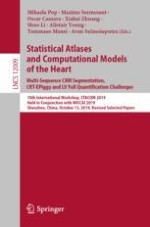2020 | Buch
Statistical Atlases and Computational Models of the Heart. Multi-Sequence CMR Segmentation, CRT-EPiggy and LV Full Quantification Challenges
10th International Workshop, STACOM 2019, Held in Conjunction with MICCAI 2019, Shenzhen, China, October 13, 2019, Revised Selected Papers
herausgegeben von: Mihaela Pop, Maxime Sermesant, Dr. Oscar Camara, Prof. Dr. Xiahai Zhuang, Shuo Li, Alistair Young, Tommaso Mansi, Avan Suinesiaputra
Verlag: Springer International Publishing
Buchreihe : Lecture Notes in Computer Science
